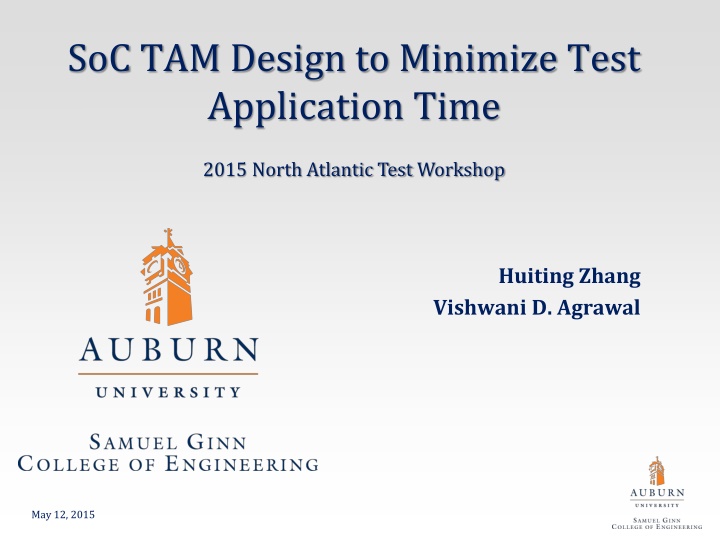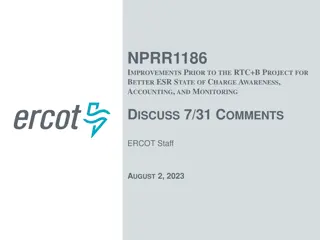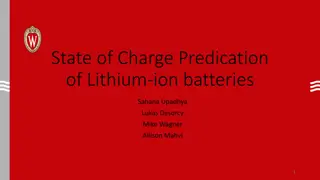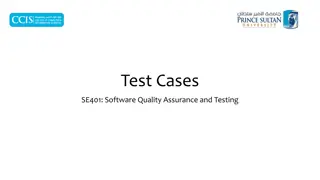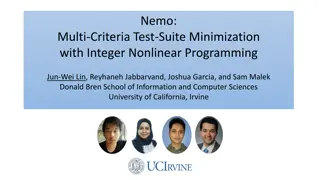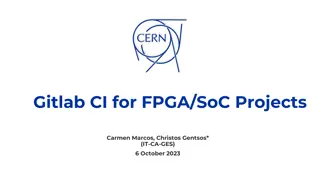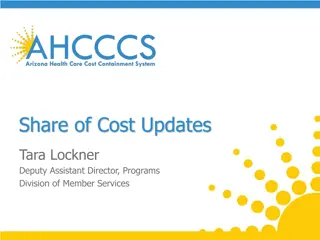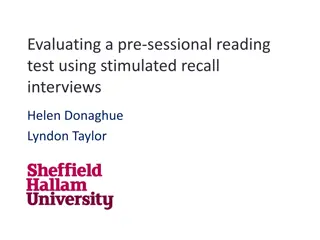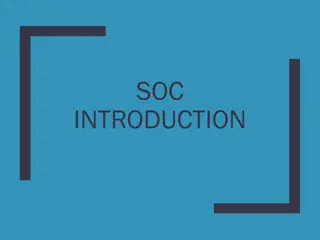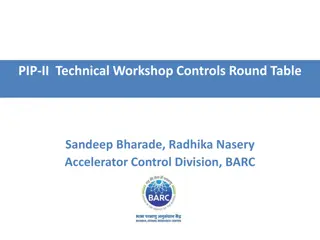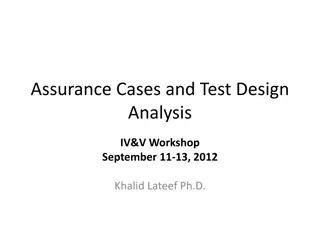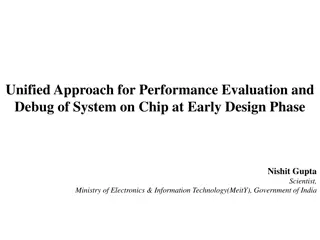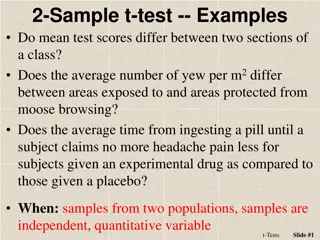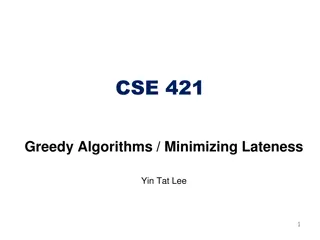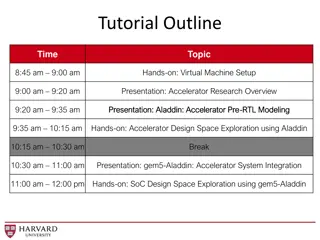Efficient Design Strategies for Minimizing Test Application Time in SoC
This paper discusses innovative design approaches to minimize test application time (TAT) in System-on-Chip (SoC) testing. It addresses challenges in incorporating hardware and power constraints into SoC test scheduling, focusing on test access mechanism (TAM) design and test scheduling strategies. The proposed methodologies aim to optimize the utilization of SoC testing resources, reduce wiring complexity, and enhance test time efficiency through dynamic voltage and frequency scaling. Additionally, it explores different TAM architectures and their impact on test time reduction and wiring complexity. The research provides insights into achieving optimal core arrangement for seamless TAM wiring and enhancing overall testing efficiency in SoC components.
Download Presentation

Please find below an Image/Link to download the presentation.
The content on the website is provided AS IS for your information and personal use only. It may not be sold, licensed, or shared on other websites without obtaining consent from the author.If you encounter any issues during the download, it is possible that the publisher has removed the file from their server.
You are allowed to download the files provided on this website for personal or commercial use, subject to the condition that they are used lawfully. All files are the property of their respective owners.
The content on the website is provided AS IS for your information and personal use only. It may not be sold, licensed, or shared on other websites without obtaining consent from the author.
E N D
Presentation Transcript
SoC TAM Design to Minimize Test Application Time 2015 North Atlantic Test Workshop Huiting Zhang Vishwani D. Agrawal May 12, 2015
Motivation With rapid growth of system-on-chip (SoC) size, there has been an enormous increase in test application time (TAT). Current SoC test scheduling fails to incorporate various hardware and power constraints introduced in this paper. 1 May 12, 2015
Proposed Work The first part is test access mechanism (TAM) design - Make effective use of SoC testing resources. - Minimize wiring complexity of previous fork and merge method. The second part is test scheduling - Include various hardware constraints in SoC test scheduling. - Dynamic voltage and frequency scaling is adopted to reduce TAT. 2 May 12, 2015
Testing of SoC Components of SoC test: Source to apply test stimuli Sink to capture test results TAM to transport test patterns and test response Wrapper Interface between TAM and cores 3 May 12, 2015
Fixed-Width TAM Architecture Disadvantage: TAM assignment cannot be explicitly tailored to each core s needs. Advantage: The wiring of TAM buses is simpler. 4 May 12, 2015
Flexible-Width TAM Architecture Advantage: A fork and merge method can increase utilization of TAM wires. Disadvantages: - increases wiring complexity of TAM, especially for large SoC. - Staircase function between TAM width and test time. 5 May 12, 2015
Proposed TAM Design Allows flexibility on internal scan chain redesign and layout arrangement of cores. Optimal core arrangement allows easy wiring of TAM. Test time drops linearly with increasing TAM through internal scan chain redesign. 6 May 12, 2015
Test Scheduling 7 May 12, 2015
Hardware Constraint of SoC Testing Hardware compatibility among cores (e.g., shared BIST) Cores in the same voltage island to be scheduled in parallel 8 May 12, 2015
Session-less Formulation : : : ( ) t t t T tfinish T F t T S t F t S t MILP Objective is to minimize TAT = + ( ) ( ) ( ) ( ) L t 0 1, if test t are executed with nth v f pairs and assigned with TAM pin choice Otherwise / , = ( , , ) . Assign t n pin 0, . = : ( , , ) 1 t T Assign t n pin n N pin C = : ( ) ( , , )* , , t T L t Assign t n pin Lt n pin n N pin C Lt,n,pin is the test time of t with nth v/f pair and assigned TAM choice This formulation is only partly shown. Need formulation for hardware and power constraints, and TAM bounds 9 May 12, 2015
Session-less Formulation Example of voltage island constraint 1, 2 t ) ( , : Assign( 1, , t ) Assign( 2, , pin n 1 ( 1, 2 )) t T n N n pin t overlap t t pin C pin C 1, 2 t ) ( , : Assign( 2, , n pin ) Assign( 1, , pi t n n 1 ( 1, 2 )) t T n N t overlap t t pin C pin C For example, when t1 and t2, which correspond to the test of c1,c2, are to be scheduled in overlap, then they must be assigned with same v/f pairs 10 May 12, 2015
Session-based Formulation The decision variable final contains 4 variables, which makes the session-based Test scheduling a very slow process. This formulation is only partly shown 11 May 12, 2015
Experimental Setup The benchmark used in this work is from ITC 02 benchmark set 12 May 12, 2015
Result 1: No DVFS, No TAM Design Up to 69% of reduction in TAT is achieved with TAM design and DVFS 13 May 12, 2015
Result 2: No DVFS , With TAM Design Only up to 10% of variance between with and without DVFS 14 May 12, 2015
Result 3: With DVFS, No TAM Design Up to 61% of variance between with and without TAM Design, which signify the effectiveness of TAM Design in TAT reduction 15 May 12, 2015
Result 4: TAT Saving by TAM Design Reference work doesn t consider hardware compatibility, Voltage Island and TAM bounds! 16 May 12, 2015
Result 5: Sessionless vs. Session-Based Scheduling Pre-defined hardware compatibility partition test into sessions. 17 May 12, 2015
Conclusion The proposed TAM design leads to noticeable improvement in the test scheduling. The novel idea of this paper is to allow flexibility in scan chain organization and core arrangement by incorporating TAM design as part of the SoC design process. In this way, SoC resources are effectively used and the TAT is reduced. This is an attempt at complete modeling of SoC testing under hardware and power constraints, which have not been addressed together all at once in the previous work. 18 May 12, 2015
Limitation In this work, SoC hierarchy is not considered. In real SoC, TAM allocation between parent cell and children cells are more difficult. ITC 02, the most adopted SoC benchmarks so far are incomplete. For accurate test scheduling result, more details are needed. Some faults are only detectable at certain voltage. The flexibility of modification on core arrangement and scan chain redesign may not be allowed for some cores in SoC. 19 May 12, 2015
References 1. S. Millican and K. K. Saluja, Optimal Test Scheduling of Stacked Circuits under Various Hardware and Power Constraints, Proc. 28thInternational Conference on VLSI Design, pp. 487-492, Jan. 2015. 2. 3DIC SoC Test Benchmarks, url:http://3dsocbench.ece.wisc.edu/ 3. V. Iyengar, K. Chakrabarty, and E. J. Marinissen, Test Access Mechanism Optimization, Test Scheduling, and Tester Data Volume Reduction for System-on-Chip, IEEE Transactions on Computers, vol. 52, no. 12, pp. 1619-1631, Dec. 2003. 4. ITC2002 SOC Benchmarking Initiative. Duke University. http://www.extra.research.philips.com/itc02socbenchm 5. V. Sheshadri, V. D. Agrawal, and P. Agrawal, Power Aware SoC Test Optimization Through Dynamic Voltage and Frequency Scaling, Proc. 21st International Conference on VLSI-SoC, pp. 102- 107, Oct. 2013. 6. V. Sheshadri, V. D. Agrawal, and P. Agrawal, Optimum Test Schedule for SoC with Specified Clock Frequencies and Supply Voltages, Proc. 26th International Conference on VLSI Design andInternational Conference on Embedded Systems, pp. 267-272 , Jan. 2013. 7. C. R. Kime and K. K. Saluja, Test Schduling in Testable VLSI Circuits, Proc. 25th IEEE International Symposium on FaultTolerant Computing, Santa Monica, pp. 406-412, 1982. 21 May 12, 2015
References 8. K. Chakrabarty, Test Scheduling for Core-Based Systems Using Mixed-Integer Linear Programming, IEEE Trans ComputerAidedDes of Integr Circ. and Syst., vol. 19, no. 10, pp. 1163-1174, Oct. 2000. 9. R. M. Chou, K. K. Saluja, and V. D. Agrawal, Scheduling Tests for VLSI Systems Under Power Constraints, IEEE Trans. VLSISystems, vol. 5, no. 2, pp. 175-185, June 1997. 10. T. Sakurai, Alpha Power-Law Model, IEEE Solid-State CircuitsSociety Newsletter, vol. 9, no. 4, pp. 4-5, Oct. 2004. 11. S. Millican and K. K. Saluja "Formulating Optimal Test Scheduling Problem with Dynamic Voltage and Frequency Scaling," Proc. 22ndAsian Test Symposium, pp. 165-170, Nov. 2013. 12. E. Larsson and H. Fujiwara, Power Constrained Preemptive TAM Scheduling Proc. Seventh IEEE European Test Workshop, pp.119- 126, Nov. 2002. 13. V. Iyengar, K. Chakrabarty, and E. J. Marinissen. Test Wrapper and Test Access Mechanism Co-Optimization for SoC, Proc.International Test Conference., pp. 1023-1032, Oct. 2001. 14. D. R. Bild, S. Misra, T. Chantemy, P. Kumar, R. P. Dick, X. S. Hu, L. Shang, and A. Choudhary, Temperature-Aware Test Scheduling for Multiprocessor Systems-on Chip, Proc. IEEE/ACM InternationalConference on Computer-Aided Design, pp. 59 66, Nov. 2008. 22 May 12, 2015
THANK YOU Questions? May 12, 2015
